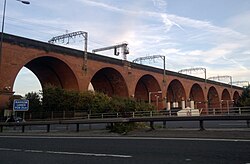Stockport Viaduct | |
|---|---|
 Stockport Viaduct | |
| Coordinates | 53°24′33″N 2°09′51″W / 53.4091°N 2.1642°W |
| Carries | West Coast Main Line |
| Crosses | River Mersey |
| Locale | Stockport, Greater Manchester |
| Official name | Stockport Viaduct |
| Owner | Network Rail |
| Maintained by | Network Rail |
| Heritage status | Grade II* listed |
| Characteristics | |
| Design | Arch bridge |
| Material | Brick |
| Total length | 547.2 m (598.4 yd) |
| Height | 111.1 ft (33.9 m) maximum |
| No. of spans | 22[1] |
| Rail characteristics | |
| No. of tracks | 4 |
| Track gauge | 1,435 mm (4 ft 8+1⁄2 in) |
| Electrified | 25 kV 50 Hz AC OHLE |
| History | |
| Engineering design by | George Watson Buck |
| Construction start | March 1839[2] |
| Construction end | December 1840[2] |
| Construction cost | £72,000[1] |
| Opened | August 1842[1] |
| Location | |
 | |
Stockport Viaduct carries the West Coast Main Line across the valley of the River Mersey in Stockport, Greater Manchester, England (grid reference SJ89089030). It is one of the largest brick structures in the United Kingdom and a major structure of the early railway age. It is immediately north of Stockport railway station.
The viaduct was designed by George Watson Buck in consultation with the architect John Lowe for the Manchester and Birmingham Railway. Work began in March 1839 and despite its scale and flooding from the Mersey, the viaduct was completed in December 1840 and services commenced the same month. Roughly 11 million bricks were used in its construction; at the time of its completion, it was the world's largest viaduct and a major feat of engineering. The viaduct is 33.85 metres (111.1 ft) high.[3][note 1] Since March 1975, Stockport Viaduct has been a Grade II* listed structure;[4] it remains one of the world's biggest brick structures.[3]
Several alterations have been made to the viaduct, in the late 1880s it was widened to accommodate four tracks by the London and North Western Railway. In the 1960s, overhead catenary lines were installed by British Rail for the West Coast Main Line electrification scheme. In the second half of the 20th century, the M60 motorway was built, passing through two of the viaduct's arches between Junction 1 (A5145 road) and Junction 27 (Portwood Roundabout). The viaduct has been subject to renovation and remedial repairs over the years.
- ^ a b c Cite error: The named reference
rail engwas invoked but never defined (see the help page). - ^ a b Cite error: The named reference
manarchitectswas invoked but never defined (see the help page). - ^ a b Historic England. "Stockport Railway Viaduct (76880)". Research records (formerly PastScape). Retrieved 25 April 2008.
- ^ Historic England. "Stockport Viaduct (1356861)". National Heritage List for England. Retrieved 29 February 2008.
Cite error: There are <ref group=note> tags on this page, but the references will not show without a {{reflist|group=note}} template (see the help page).